Related Research Articles

Horse teeth refers to the dentition of equine species, including horses and donkeys. Equines are both heterodontous and diphyodontous, which means that they have teeth in more than one shape, and have two successive sets of teeth, the deciduous and permanent sets.

Human teeth function to mechanically break down items of food by cutting and crushing them in preparation for swallowing and digesting. As such, they are considered part of the human digestive system. Humans have four types of teeth: incisors, canines, premolars, and molars, which each have a specific function. The incisors cut the food, the canines tear the food and the molars and premolars crush the food. The roots of teeth are embedded in the maxilla or the mandible and are covered by gums. Teeth are made of multiple tissues of varying density and hardness.
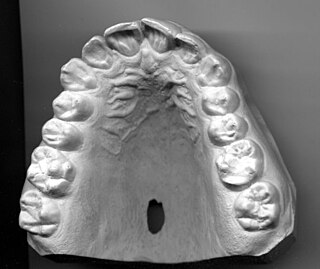
Dentition pertains to the development of teeth and their arrangement in the mouth. In particular, it is the characteristic arrangement, kind, and number of teeth in a given species at a given age. That is, the number, type, and morpho-physiology of the teeth of an animal.

The Cape Flats is an expansive, low-lying, flat area situated to the southeast of the central business district of Cape Town. The Cape Flats is also the name of an administrative region of the City of Cape Town, which lies within the larger geographical area.
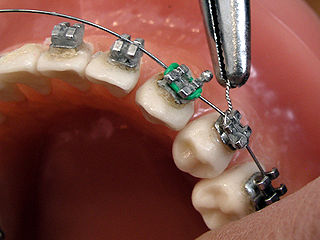
Orthodontics is a dentistry specialty that addresses the diagnosis, prevention, management, and correction of mal-positioned teeth and jaws, as well as misaligned bite patterns. It may also address the modification of facial growth, known as dentofacial orthopedics.
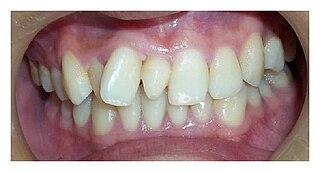
Hyperdontia is the condition of having supernumerary teeth, or teeth that appear in addition to the regular number of teeth. They can appear in any area of the dental arch and can affect any dental organ. The opposite of hyperdontia is hypodontia, where there is a congenital lack of teeth, which is a condition seen more commonly than hyperdontia. The scientific definition of hyperdontia is "any tooth or odontogenic structure that is formed from tooth germ in excess of usual number for any given region of the dental arch." The additional teeth, which may be few or many, can occur on any place in the dental arch. Their arrangement may be symmetrical or non-symmetrical.
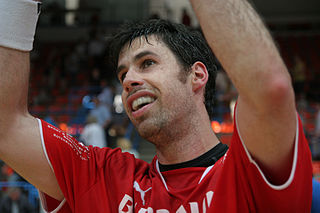
A mouthguard is a protective device for the mouth that covers the teeth and gums to prevent and reduce injury to the teeth, arches, lips and gums. An effective mouthguard is like a crash helmet for teeth and jaws. It also prevents the jaws coming together fully, thereby reducing the risk of jaw joint injuries and concussion. A mouthguard is most often used to prevent injury in contact sports, as a treatment for bruxism or TMD, or as part of certain dental procedures, such as tooth bleaching or sleep apnea treatment. Depending on the application, it may also be called a mouth protector, mouth piece, gumshield, gumguard, nightguard, occlusal splint, bite splint, or bite plane. The dentists who specialise in sports dentistry fabricate mouthguards.

In orthodontics, a malocclusion is a misalignment or incorrect relation between the teeth of the upper and lower dental arches when they approach each other as the jaws close. The English-language term dates from 1864; Edward Angle (1855–1930), the "father of modern orthodontics", popularised it. The word "malocclusion" derives from occlusion, and refers to the manner in which opposing teeth meet.

A dental extraction is the removal of teeth from the dental alveolus (socket) in the alveolar bone. Extractions are performed for a wide variety of reasons, but most commonly to remove teeth which have become unrestorable through tooth decay, periodontal disease, or dental trauma, especially when they are associated with toothache. Sometimes impacted wisdom teeth cause recurrent infections of the gum (pericoronitis), and may be removed when other conservative treatments have failed. In orthodontics, if the teeth are crowded, healthy teeth may be extracted to create space so the rest of the teeth can be straightened.
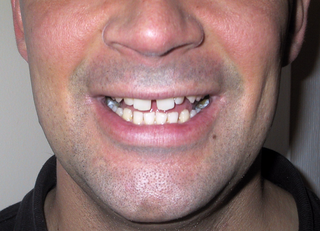
A diastema is a space or gap between two teeth. Many species of mammals have diastemata as a normal feature, most commonly between the incisors and molars. More colloquially, the condition may be referred to as gap teeth or tooth gap.

In pop culture, a grill, also known as fronts or golds, is a type of dental jewelry worn over the teeth. Grills are made of metal and are generally removable but can also be permanent. They were popularized by hip-hop artists in New York City in the early 1980s, and upgraded during the 1990s in Oakland. They became even more widely popular during the mid-2000s due to the rise of Southern hip hop rap and the more mainstream pop culture status hip hop attained. Since then, grills have reached the mainstream; a "hard flex of both style and wealth, grillz have always been a symbol of power and social status – right from its origins that can be traced back to over 4,000 years ago." African men and women are said to have worn grills to show their status up until modern days. Although grills have been around for over 4,000 years, the rise and fall of their popularity at different times in different countries is a reflection of fashion trends.

Gold teeth are a form of dental prosthesis where the visible part of a tooth is replaced or capped with a prosthetic molded from gold.
Dilaceration is a developmental disturbance in shape of teeth. It refers to an angulation, or a sharp bend or curve, in the root or crown of a formed tooth. This disturbance is more likely to affect the maxillary incisors and occurs in permanent dentition. Although this may seem more of an aesthetics issue, an impacted maxillary incisor will cause issues related to occlusion, phonetics, mastication, and psychology on young patients.
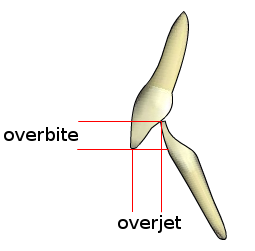
Overjet is the extent of horizontal (anterior-posterior) overlap of the maxillary central incisors over the mandibular central incisors. In class II malocclusion the overjet is increased as the maxillary central incisors are protruded.
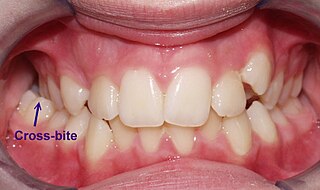
Crossbite is a form of malocclusion where a tooth has a more buccal or lingual position than its corresponding antagonist tooth in the upper or lower dental arch. In other words, crossbite is a lateral misalignment of the dental arches.

A toothcomb is a dental structure found in some mammals, comprising a group of front teeth arranged in a manner that facilitates grooming, similar to a hair comb. The toothcomb occurs in lemuriform primates, treeshrews, colugos, hyraxes, and some African antelopes. The structures evolved independently in different types of mammals through convergent evolution and vary both in dental composition and structure. In most mammals the comb is formed by a group of teeth with fine spaces between them. The toothcombs in most mammals include incisors only, while in lemuriform primates they include incisors and canine teeth that tilt forward at the front of the lower jaw, followed by a canine-shaped first premolar. The toothcombs of colugos and hyraxes take a different form with the individual incisors being serrated, providing multiple tines per tooth.

A tooth is a hard, calcified structure found in the jaws of many vertebrates and used to break down food. Some animals, particularly carnivores and omnivores, also use teeth to help with capturing or wounding prey, tearing food, for defensive purposes, to intimidate other animals often including their own, or to carry prey or their young. The roots of teeth are covered by gums. Teeth are not made of bone, but rather of multiple tissues of varying density and hardness that originate from the outermost embryonic germ layer, the ectoderm.
Open bite is a type of orthodontic malocclusion which has been estimated to occur in 0.6% of the people in the United States. This type of malocclusion has no vertical overlap or contact between the anterior incisors. The term "open bite" was coined by Carevelli in 1842 as a distinct classification of malocclusion. Different authors have described the open bite in a variety of ways. Some authors have suggested that open bite often arises when overbite is less than the usual amount. Additionally, others have contended that open bite is identified by end-on incisal relationships. Lastly, some researchers have stated that a lack of incisal contact must be present to diagnose an open bite.

Tooth ablation is the deliberate removal of a person's healthy teeth, and has been recorded in a variety of ancient and modern societies around the world. This type of dental modification is visually very striking and immediately obvious to other people from the same or different communities. There are numerous reasons for performing tooth ablation, including group identification, ornamentation, and rites of passage such as coming of age, marriage and mourning. The social meaning of tooth evulsion is likely to remain unknown for ancient populations and may have changed over time within those groups. Dental evulsion can significantly affect the emergence, occlusion and wear patterns of the remaining teeth.
Dentistry developed during the early parts of Roman history, which may be due to the arrival of a Greek doctor named Archagathus. Ancient Roman oral surgical tools included the curettes, osteotomes, cauteries, scalpels, bone forceps, and bone levers. The ancient Romans invented the usage of narcotics during dental surgery. These tools were used to treat conditions such as toothache and to extract teeth. It was believed in ancient Rome that the cause of the conditions that necessitated such treatment was a "tooth worm."
References
- 1 2 3 Fran Blandy (2009-10-07). "Cape Town's passion gap: sexual myth or fashion victimhood?". The Telegraph . Retrieved 2014-04-03.
- ↑ Jamie Clifton (2012-03-06). "SMILE AND SAY "PASSION GAP"". Vice . Retrieved 2014-04-03.
- 1 2 Biénne Huisman (2013-08-25). "Toothy truth of the 'Cape Flats smile'". City Press. Archived from the original on 2014-03-20. Retrieved 2014-04-03.
- ↑ Ezelle Solomons (2011-02-02). "No 'passion gap', supermarket staff told". News24. Retrieved 2014-04-03.
- ↑ Morris AG (1998). "Dental mutilation in southern African history and prehistory with special reference to the "Cape Flats Smile"". South African Dental Journal. 53 (4). University of Cape Town Medical School: 179–83. PMID 9760932.